Leadership and Management in Operations: Theories and Applications
VerifiedAdded on 2024/06/07
|25
|6382
|422
Report
AI Summary
This report provides a comprehensive analysis of leadership and management within the context of operations management. It defines and compares the roles and characteristics of leaders and managers, highlighting their functions in various situations, including fast-changing, slow-to-moderate changing, and stable environments. The report also applies different theories and models of approach, such as situational leadership, systems leadership, and contingency theory, to illustrate how these concepts can be utilized in real-world scenarios. Furthermore, it touches upon various operations management theories and approaches, including six-sigma, total quality management, queuing theory, lean production, just-in-time, and continuous improvement (kaizen). The report emphasizes the significance of operations management in achieving organizational aims and objectives, and briefly mentions the influence of factors like organizational culture, CSR, stakeholders, and sustainability methods on the decision-making processes of leaders and managers.
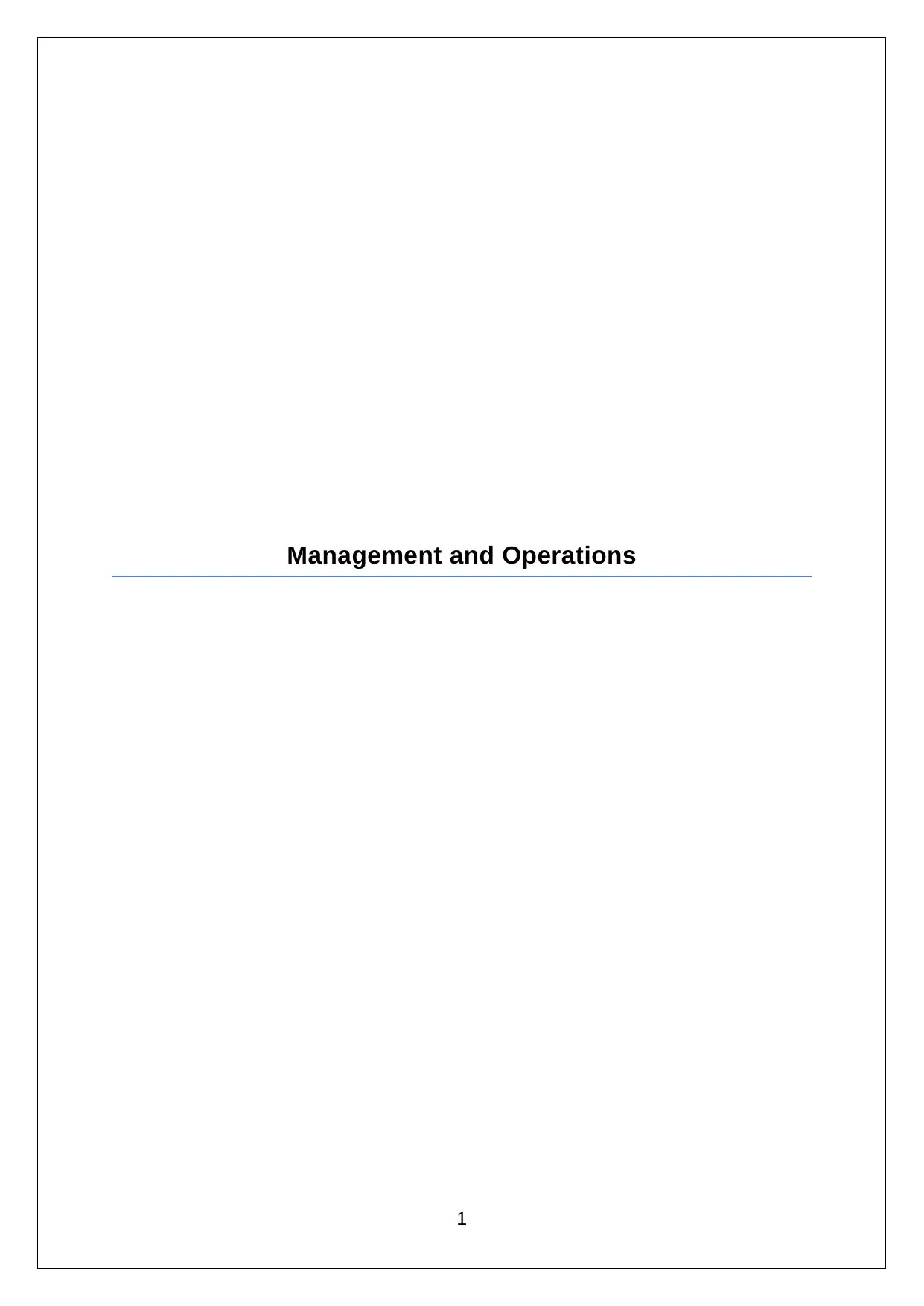
Management and Operations
1
1
Paraphrase This Document
Need a fresh take? Get an instant paraphrase of this document with our AI Paraphraser
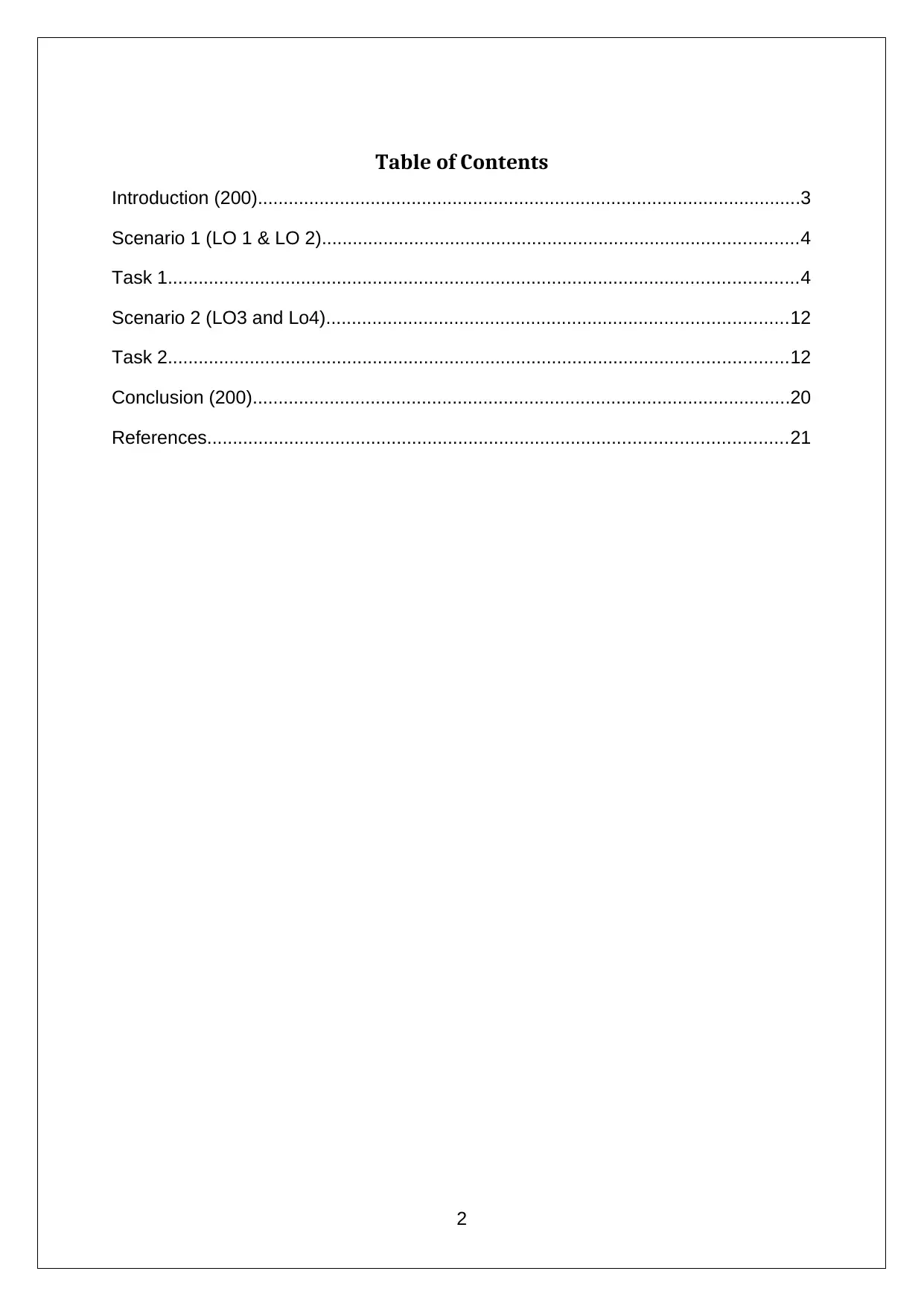
Table of Contents
Introduction (200)..........................................................................................................3
Scenario 1 (LO 1 & LO 2).............................................................................................4
Task 1...........................................................................................................................4
Scenario 2 (LO3 and Lo4)..........................................................................................12
Task 2.........................................................................................................................12
Conclusion (200).........................................................................................................20
References.................................................................................................................21
2
Introduction (200)..........................................................................................................3
Scenario 1 (LO 1 & LO 2).............................................................................................4
Task 1...........................................................................................................................4
Scenario 2 (LO3 and Lo4)..........................................................................................12
Task 2.........................................................................................................................12
Conclusion (200).........................................................................................................20
References.................................................................................................................21
2
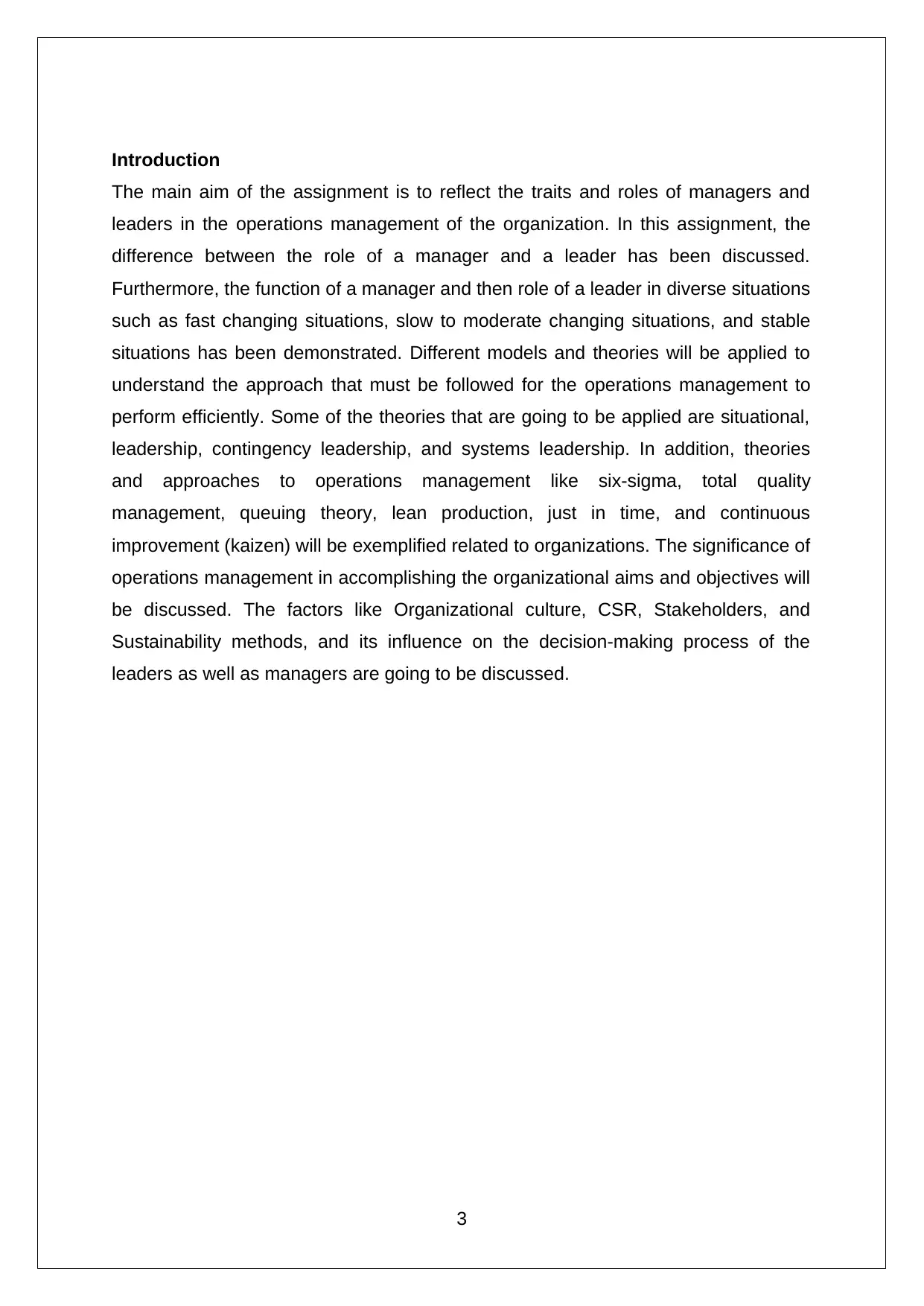
Introduction
The main aim of the assignment is to reflect the traits and roles of managers and
leaders in the operations management of the organization. In this assignment, the
difference between the role of a manager and a leader has been discussed.
Furthermore, the function of a manager and then role of a leader in diverse situations
such as fast changing situations, slow to moderate changing situations, and stable
situations has been demonstrated. Different models and theories will be applied to
understand the approach that must be followed for the operations management to
perform efficiently. Some of the theories that are going to be applied are situational,
leadership, contingency leadership, and systems leadership. In addition, theories
and approaches to operations management like six-sigma, total quality
management, queuing theory, lean production, just in time, and continuous
improvement (kaizen) will be exemplified related to organizations. The significance of
operations management in accomplishing the organizational aims and objectives will
be discussed. The factors like Organizational culture, CSR, Stakeholders, and
Sustainability methods, and its influence on the decision-making process of the
leaders as well as managers are going to be discussed.
3
The main aim of the assignment is to reflect the traits and roles of managers and
leaders in the operations management of the organization. In this assignment, the
difference between the role of a manager and a leader has been discussed.
Furthermore, the function of a manager and then role of a leader in diverse situations
such as fast changing situations, slow to moderate changing situations, and stable
situations has been demonstrated. Different models and theories will be applied to
understand the approach that must be followed for the operations management to
perform efficiently. Some of the theories that are going to be applied are situational,
leadership, contingency leadership, and systems leadership. In addition, theories
and approaches to operations management like six-sigma, total quality
management, queuing theory, lean production, just in time, and continuous
improvement (kaizen) will be exemplified related to organizations. The significance of
operations management in accomplishing the organizational aims and objectives will
be discussed. The factors like Organizational culture, CSR, Stakeholders, and
Sustainability methods, and its influence on the decision-making process of the
leaders as well as managers are going to be discussed.
3
⊘ This is a preview!⊘
Do you want full access?
Subscribe today to unlock all pages.

Trusted by 1+ million students worldwide
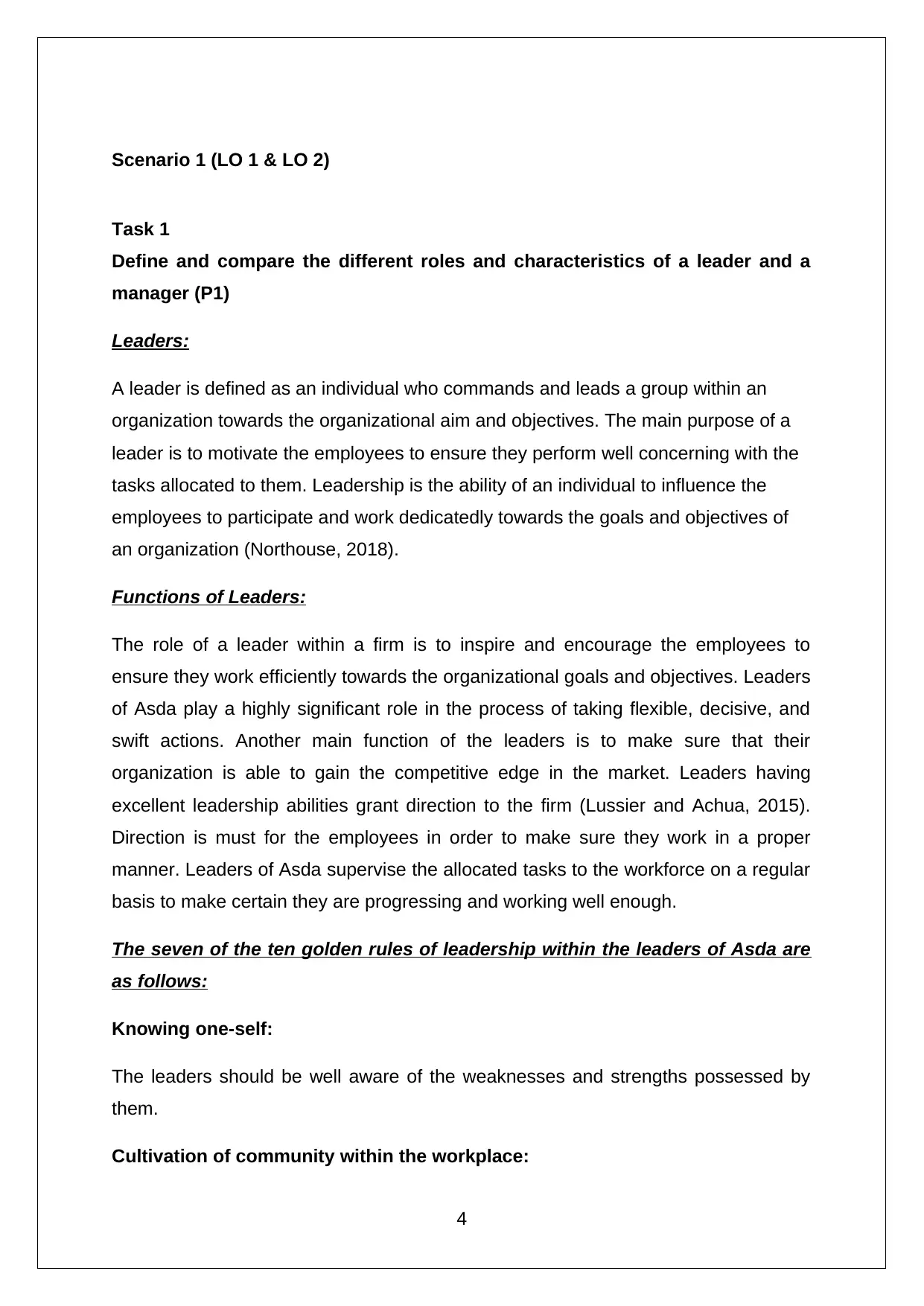
Scenario 1 (LO 1 & LO 2)
Task 1
Define and compare the different roles and characteristics of a leader and a
manager (P1)
Leaders:
A leader is defined as an individual who commands and leads a group within an
organization towards the organizational aim and objectives. The main purpose of a
leader is to motivate the employees to ensure they perform well concerning with the
tasks allocated to them. Leadership is the ability of an individual to influence the
employees to participate and work dedicatedly towards the goals and objectives of
an organization (Northouse, 2018).
Functions of Leaders:
The role of a leader within a firm is to inspire and encourage the employees to
ensure they work efficiently towards the organizational goals and objectives. Leaders
of Asda play a highly significant role in the process of taking flexible, decisive, and
swift actions. Another main function of the leaders is to make sure that their
organization is able to gain the competitive edge in the market. Leaders having
excellent leadership abilities grant direction to the firm (Lussier and Achua, 2015).
Direction is must for the employees in order to make sure they work in a proper
manner. Leaders of Asda supervise the allocated tasks to the workforce on a regular
basis to make certain they are progressing and working well enough.
The seven of the ten golden rules of leadership within the leaders of Asda are
as follows:
Knowing one-self:
The leaders should be well aware of the weaknesses and strengths possessed by
them.
Cultivation of community within the workplace:
4
Task 1
Define and compare the different roles and characteristics of a leader and a
manager (P1)
Leaders:
A leader is defined as an individual who commands and leads a group within an
organization towards the organizational aim and objectives. The main purpose of a
leader is to motivate the employees to ensure they perform well concerning with the
tasks allocated to them. Leadership is the ability of an individual to influence the
employees to participate and work dedicatedly towards the goals and objectives of
an organization (Northouse, 2018).
Functions of Leaders:
The role of a leader within a firm is to inspire and encourage the employees to
ensure they work efficiently towards the organizational goals and objectives. Leaders
of Asda play a highly significant role in the process of taking flexible, decisive, and
swift actions. Another main function of the leaders is to make sure that their
organization is able to gain the competitive edge in the market. Leaders having
excellent leadership abilities grant direction to the firm (Lussier and Achua, 2015).
Direction is must for the employees in order to make sure they work in a proper
manner. Leaders of Asda supervise the allocated tasks to the workforce on a regular
basis to make certain they are progressing and working well enough.
The seven of the ten golden rules of leadership within the leaders of Asda are
as follows:
Knowing one-self:
The leaders should be well aware of the weaknesses and strengths possessed by
them.
Cultivation of community within the workplace:
4
Paraphrase This Document
Need a fresh take? Get an instant paraphrase of this document with our AI Paraphraser
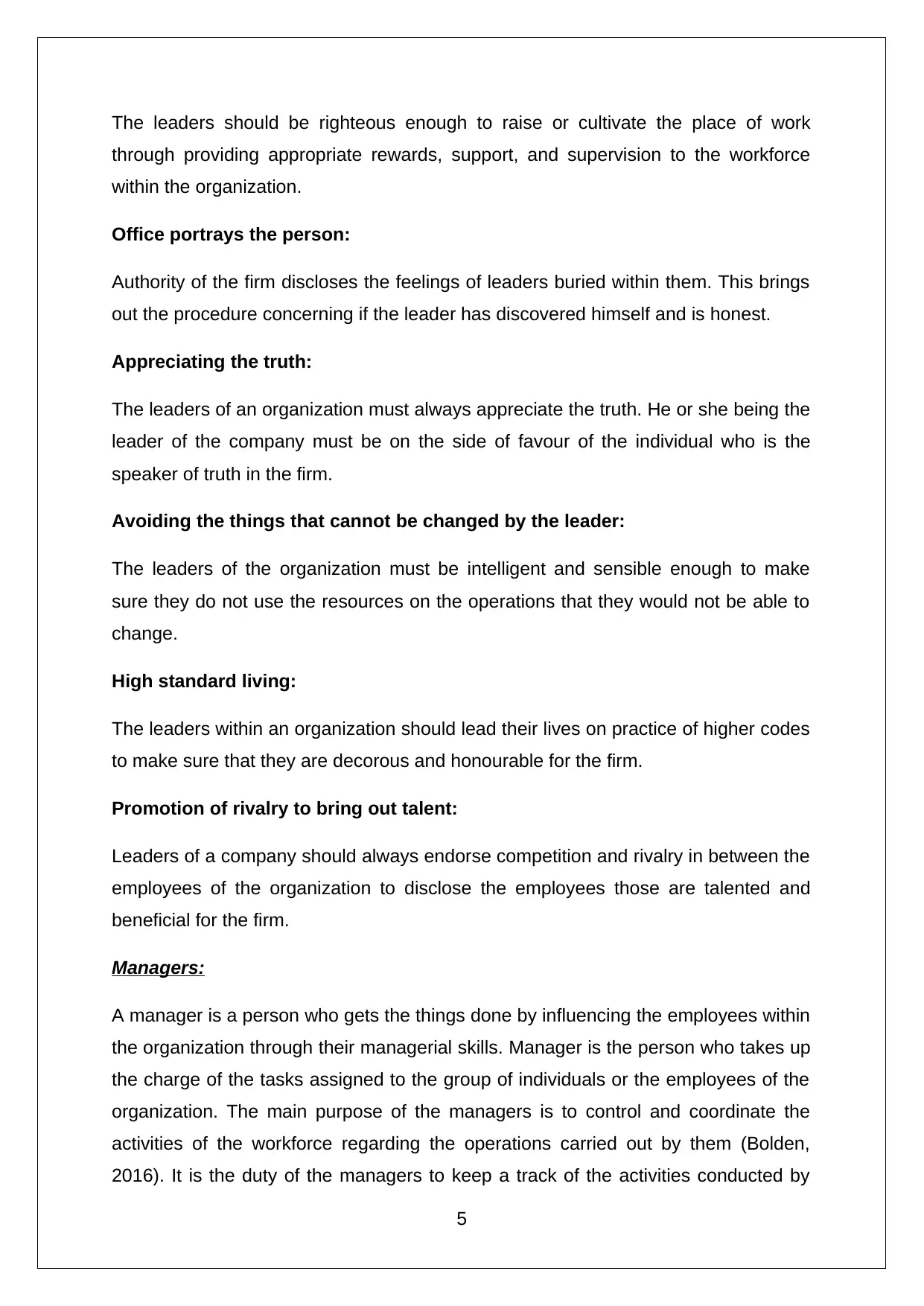
The leaders should be righteous enough to raise or cultivate the place of work
through providing appropriate rewards, support, and supervision to the workforce
within the organization.
Office portrays the person:
Authority of the firm discloses the feelings of leaders buried within them. This brings
out the procedure concerning if the leader has discovered himself and is honest.
Appreciating the truth:
The leaders of an organization must always appreciate the truth. He or she being the
leader of the company must be on the side of favour of the individual who is the
speaker of truth in the firm.
Avoiding the things that cannot be changed by the leader:
The leaders of the organization must be intelligent and sensible enough to make
sure they do not use the resources on the operations that they would not be able to
change.
High standard living:
The leaders within an organization should lead their lives on practice of higher codes
to make sure that they are decorous and honourable for the firm.
Promotion of rivalry to bring out talent:
Leaders of a company should always endorse competition and rivalry in between the
employees of the organization to disclose the employees those are talented and
beneficial for the firm.
Managers:
A manager is a person who gets the things done by influencing the employees within
the organization through their managerial skills. Manager is the person who takes up
the charge of the tasks assigned to the group of individuals or the employees of the
organization. The main purpose of the managers is to control and coordinate the
activities of the workforce regarding the operations carried out by them (Bolden,
2016). It is the duty of the managers to keep a track of the activities conducted by
5
through providing appropriate rewards, support, and supervision to the workforce
within the organization.
Office portrays the person:
Authority of the firm discloses the feelings of leaders buried within them. This brings
out the procedure concerning if the leader has discovered himself and is honest.
Appreciating the truth:
The leaders of an organization must always appreciate the truth. He or she being the
leader of the company must be on the side of favour of the individual who is the
speaker of truth in the firm.
Avoiding the things that cannot be changed by the leader:
The leaders of the organization must be intelligent and sensible enough to make
sure they do not use the resources on the operations that they would not be able to
change.
High standard living:
The leaders within an organization should lead their lives on practice of higher codes
to make sure that they are decorous and honourable for the firm.
Promotion of rivalry to bring out talent:
Leaders of a company should always endorse competition and rivalry in between the
employees of the organization to disclose the employees those are talented and
beneficial for the firm.
Managers:
A manager is a person who gets the things done by influencing the employees within
the organization through their managerial skills. Manager is the person who takes up
the charge of the tasks assigned to the group of individuals or the employees of the
organization. The main purpose of the managers is to control and coordinate the
activities of the workforce regarding the operations carried out by them (Bolden,
2016). It is the duty of the managers to keep a track of the activities conducted by
5
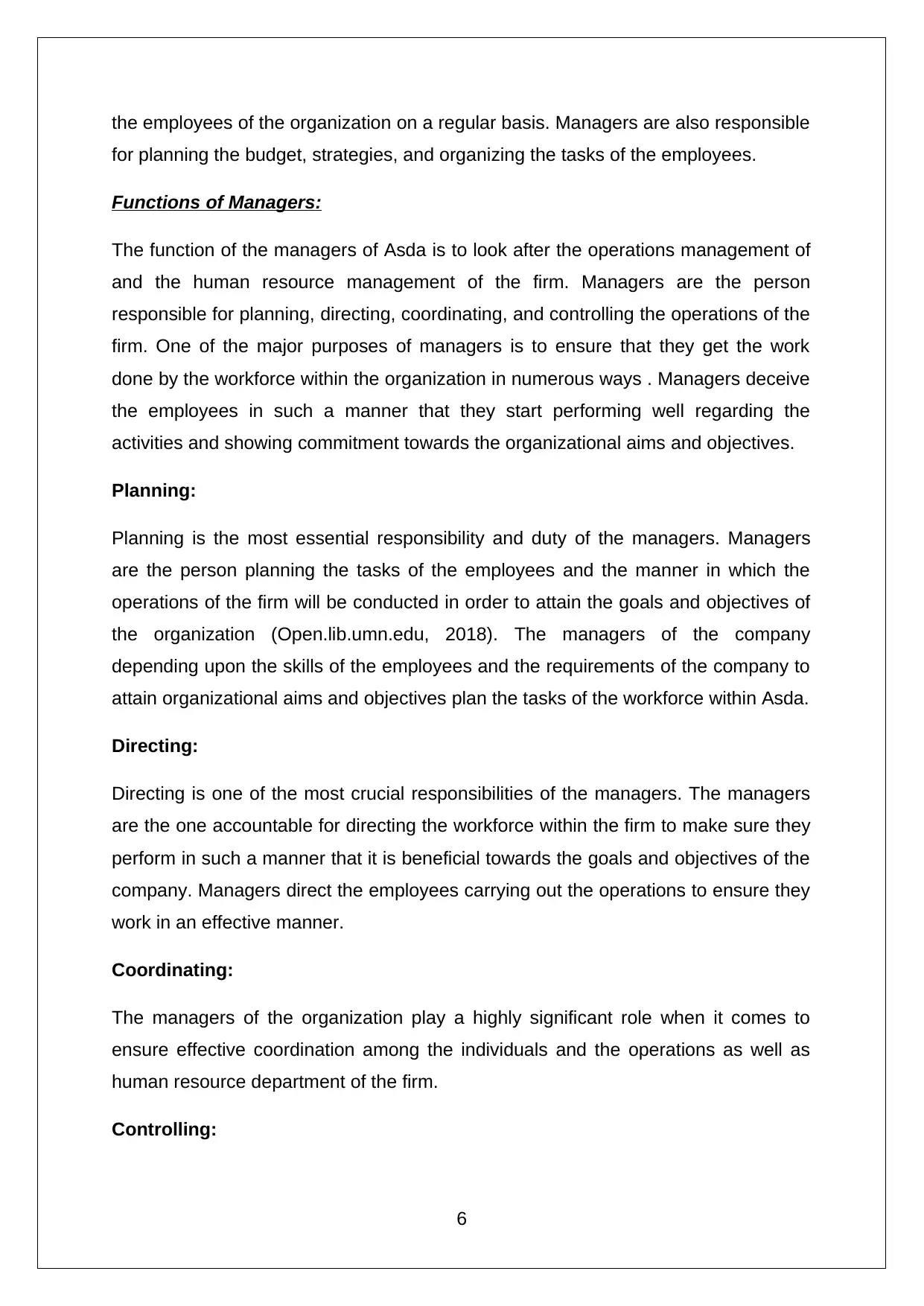
the employees of the organization on a regular basis. Managers are also responsible
for planning the budget, strategies, and organizing the tasks of the employees.
Functions of Managers:
The function of the managers of Asda is to look after the operations management of
and the human resource management of the firm. Managers are the person
responsible for planning, directing, coordinating, and controlling the operations of the
firm. One of the major purposes of managers is to ensure that they get the work
done by the workforce within the organization in numerous ways . Managers deceive
the employees in such a manner that they start performing well regarding the
activities and showing commitment towards the organizational aims and objectives.
Planning:
Planning is the most essential responsibility and duty of the managers. Managers
are the person planning the tasks of the employees and the manner in which the
operations of the firm will be conducted in order to attain the goals and objectives of
the organization (Open.lib.umn.edu, 2018). The managers of the company
depending upon the skills of the employees and the requirements of the company to
attain organizational aims and objectives plan the tasks of the workforce within Asda.
Directing:
Directing is one of the most crucial responsibilities of the managers. The managers
are the one accountable for directing the workforce within the firm to make sure they
perform in such a manner that it is beneficial towards the goals and objectives of the
company. Managers direct the employees carrying out the operations to ensure they
work in an effective manner.
Coordinating:
The managers of the organization play a highly significant role when it comes to
ensure effective coordination among the individuals and the operations as well as
human resource department of the firm.
Controlling:
6
for planning the budget, strategies, and organizing the tasks of the employees.
Functions of Managers:
The function of the managers of Asda is to look after the operations management of
and the human resource management of the firm. Managers are the person
responsible for planning, directing, coordinating, and controlling the operations of the
firm. One of the major purposes of managers is to ensure that they get the work
done by the workforce within the organization in numerous ways . Managers deceive
the employees in such a manner that they start performing well regarding the
activities and showing commitment towards the organizational aims and objectives.
Planning:
Planning is the most essential responsibility and duty of the managers. Managers
are the person planning the tasks of the employees and the manner in which the
operations of the firm will be conducted in order to attain the goals and objectives of
the organization (Open.lib.umn.edu, 2018). The managers of the company
depending upon the skills of the employees and the requirements of the company to
attain organizational aims and objectives plan the tasks of the workforce within Asda.
Directing:
Directing is one of the most crucial responsibilities of the managers. The managers
are the one accountable for directing the workforce within the firm to make sure they
perform in such a manner that it is beneficial towards the goals and objectives of the
company. Managers direct the employees carrying out the operations to ensure they
work in an effective manner.
Coordinating:
The managers of the organization play a highly significant role when it comes to
ensure effective coordination among the individuals and the operations as well as
human resource department of the firm.
Controlling:
6
⊘ This is a preview!⊘
Do you want full access?
Subscribe today to unlock all pages.

Trusted by 1+ million students worldwide
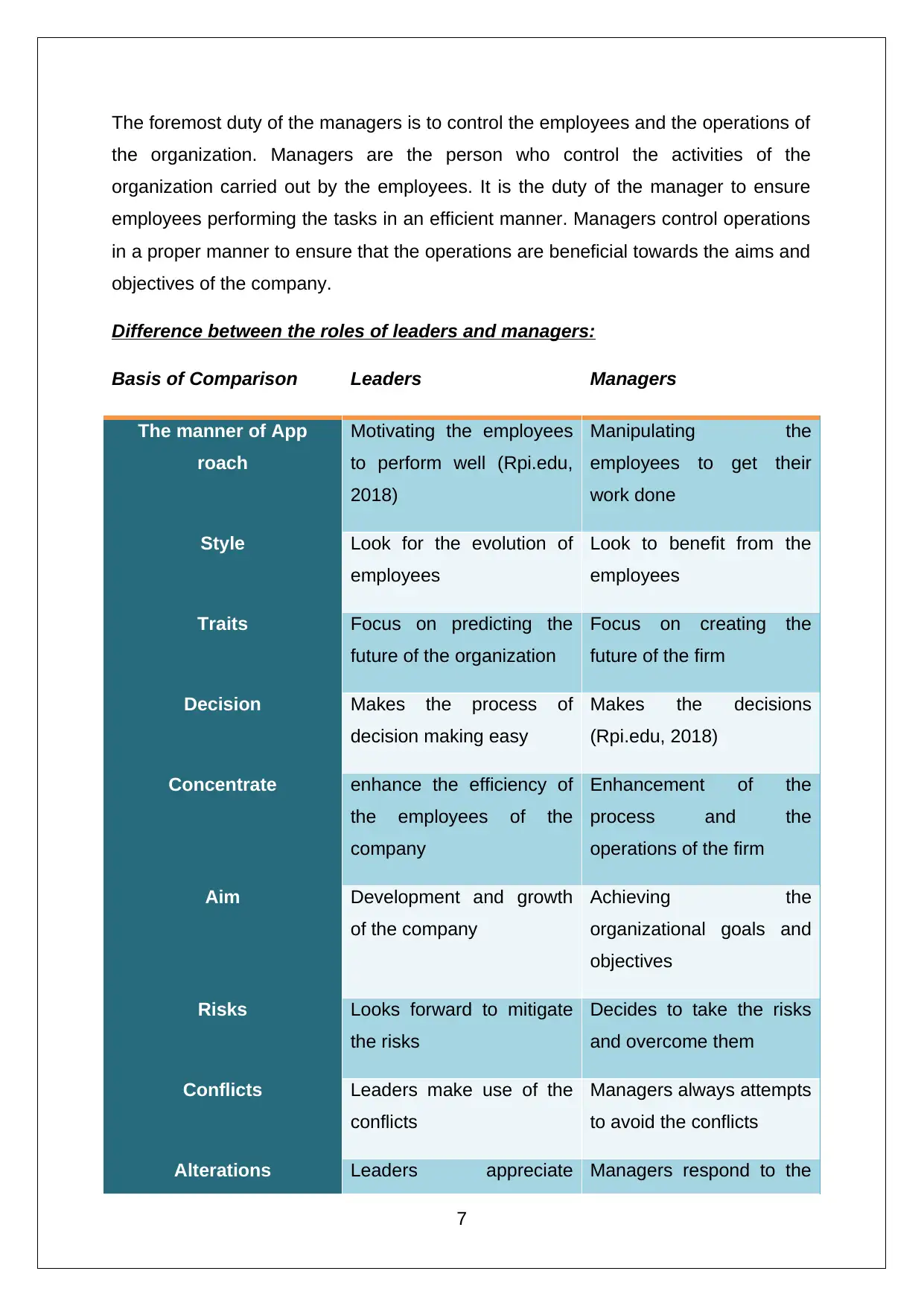
The foremost duty of the managers is to control the employees and the operations of
the organization. Managers are the person who control the activities of the
organization carried out by the employees. It is the duty of the manager to ensure
employees performing the tasks in an efficient manner. Managers control operations
in a proper manner to ensure that the operations are beneficial towards the aims and
objectives of the company.
Difference between the roles of leaders and managers:
Basis of Comparison Leaders Managers
The manner of App
roach
Motivating the employees
to perform well (Rpi.edu,
2018)
Manipulating the
employees to get their
work done
Style Look for the evolution of
employees
Look to benefit from the
employees
Traits Focus on predicting the
future of the organization
Focus on creating the
future of the firm
Decision Makes the process of
decision making easy
Makes the decisions
(Rpi.edu, 2018)
Concentrate enhance the efficiency of
the employees of the
company
Enhancement of the
process and the
operations of the firm
Aim Development and growth
of the company
Achieving the
organizational goals and
objectives
Risks Looks forward to mitigate
the risks
Decides to take the risks
and overcome them
Conflicts Leaders make use of the
conflicts
Managers always attempts
to avoid the conflicts
Alterations Leaders appreciate Managers respond to the
7
the organization. Managers are the person who control the activities of the
organization carried out by the employees. It is the duty of the manager to ensure
employees performing the tasks in an efficient manner. Managers control operations
in a proper manner to ensure that the operations are beneficial towards the aims and
objectives of the company.
Difference between the roles of leaders and managers:
Basis of Comparison Leaders Managers
The manner of App
roach
Motivating the employees
to perform well (Rpi.edu,
2018)
Manipulating the
employees to get their
work done
Style Look for the evolution of
employees
Look to benefit from the
employees
Traits Focus on predicting the
future of the organization
Focus on creating the
future of the firm
Decision Makes the process of
decision making easy
Makes the decisions
(Rpi.edu, 2018)
Concentrate enhance the efficiency of
the employees of the
company
Enhancement of the
process and the
operations of the firm
Aim Development and growth
of the company
Achieving the
organizational goals and
objectives
Risks Looks forward to mitigate
the risks
Decides to take the risks
and overcome them
Conflicts Leaders make use of the
conflicts
Managers always attempts
to avoid the conflicts
Alterations Leaders appreciate Managers respond to the
7
Paraphrase This Document
Need a fresh take? Get an instant paraphrase of this document with our AI Paraphraser
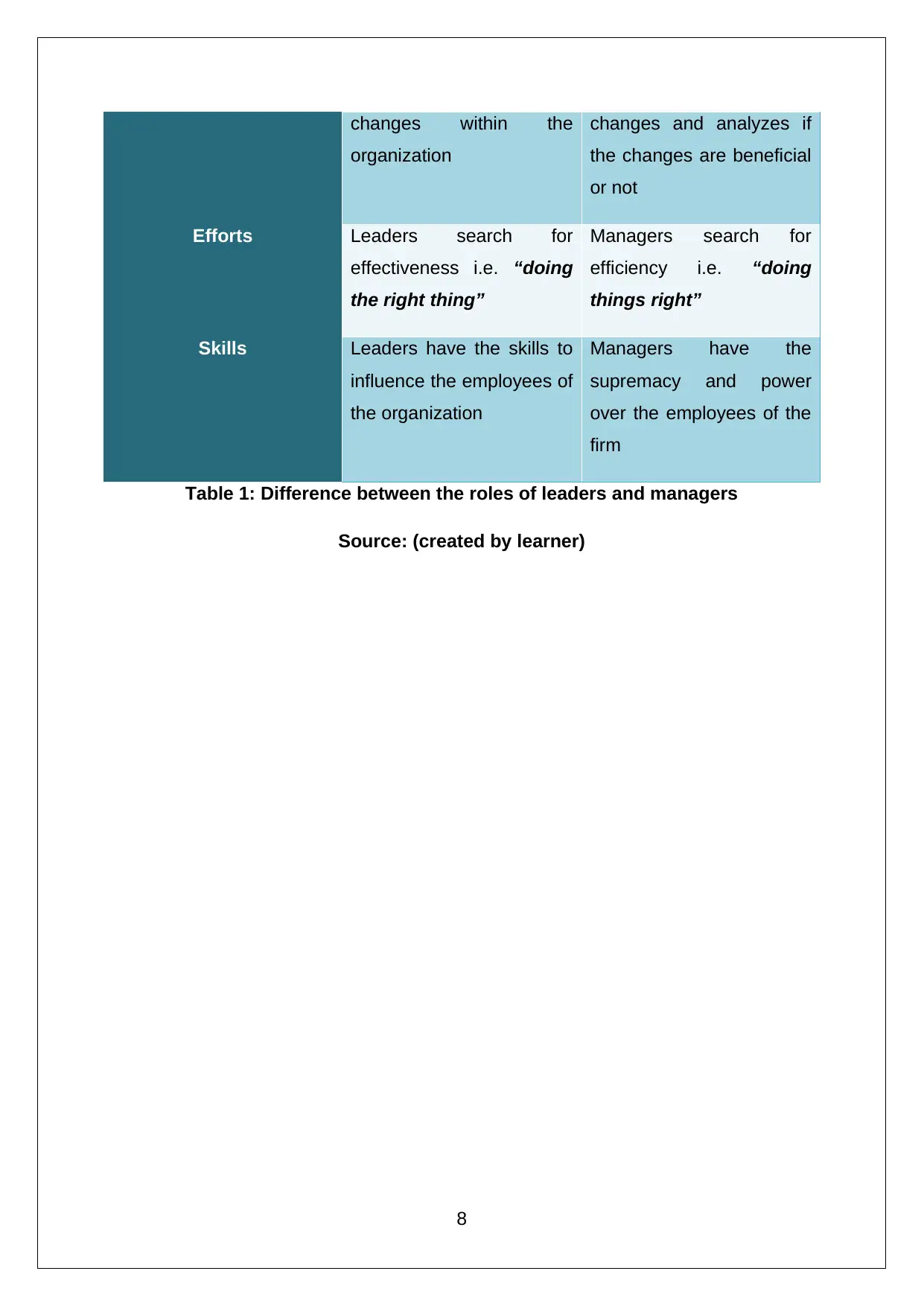
changes within the
organization
changes and analyzes if
the changes are beneficial
or not
Efforts Leaders search for
effectiveness i.e. “doing
the right thing”
Managers search for
efficiency i.e. “doing
things right”
Skills Leaders have the skills to
influence the employees of
the organization
Managers have the
supremacy and power
over the employees of the
firm
Table 1: Difference between the roles of leaders and managers
Source: (created by learner)
8
organization
changes and analyzes if
the changes are beneficial
or not
Efforts Leaders search for
effectiveness i.e. “doing
the right thing”
Managers search for
efficiency i.e. “doing
things right”
Skills Leaders have the skills to
influence the employees of
the organization
Managers have the
supremacy and power
over the employees of the
firm
Table 1: Difference between the roles of leaders and managers
Source: (created by learner)
8
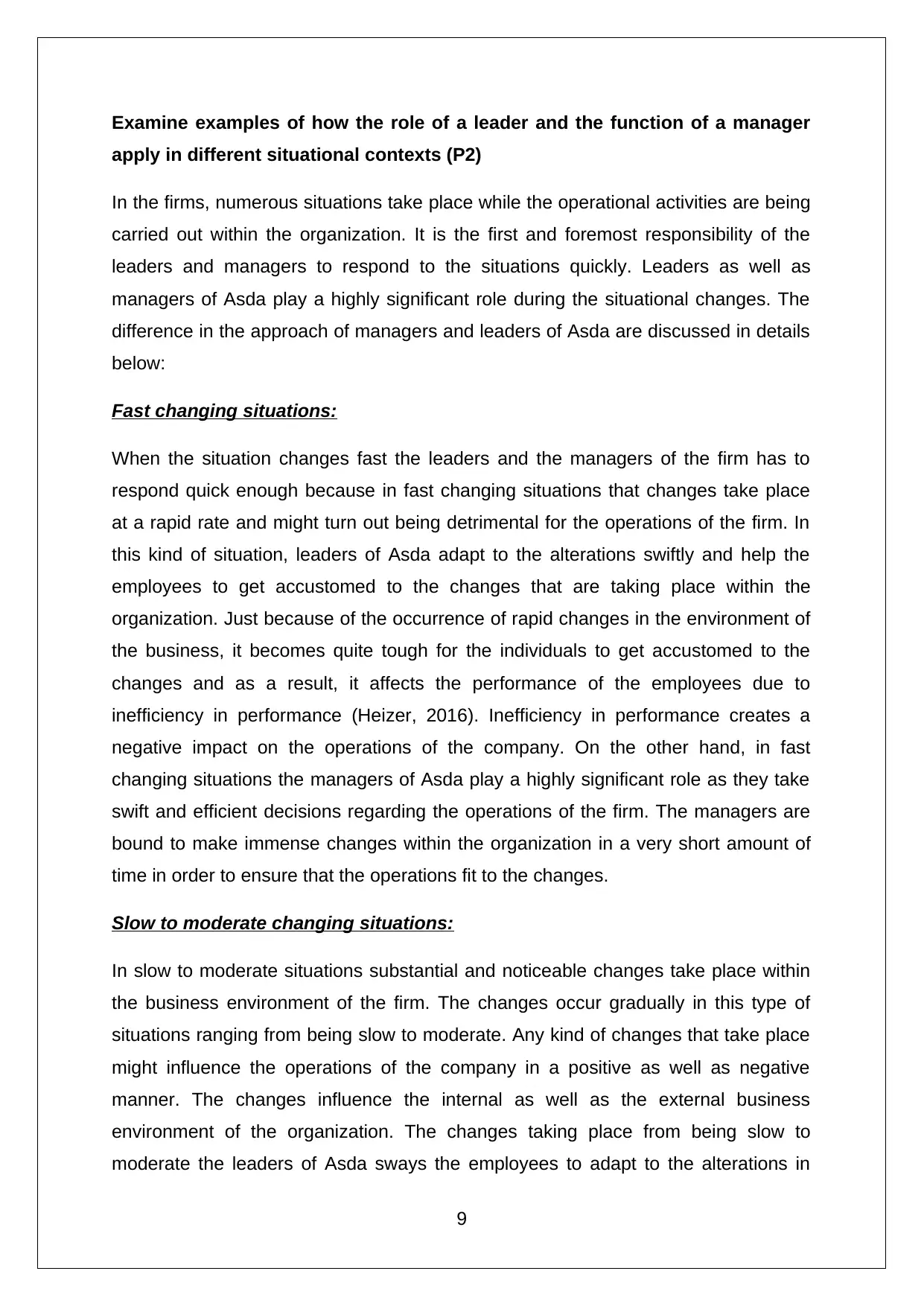
Examine examples of how the role of a leader and the function of a manager
apply in different situational contexts (P2)
In the firms, numerous situations take place while the operational activities are being
carried out within the organization. It is the first and foremost responsibility of the
leaders and managers to respond to the situations quickly. Leaders as well as
managers of Asda play a highly significant role during the situational changes. The
difference in the approach of managers and leaders of Asda are discussed in details
below:
Fast changing situations:
When the situation changes fast the leaders and the managers of the firm has to
respond quick enough because in fast changing situations that changes take place
at a rapid rate and might turn out being detrimental for the operations of the firm. In
this kind of situation, leaders of Asda adapt to the alterations swiftly and help the
employees to get accustomed to the changes that are taking place within the
organization. Just because of the occurrence of rapid changes in the environment of
the business, it becomes quite tough for the individuals to get accustomed to the
changes and as a result, it affects the performance of the employees due to
inefficiency in performance (Heizer, 2016). Inefficiency in performance creates a
negative impact on the operations of the company. On the other hand, in fast
changing situations the managers of Asda play a highly significant role as they take
swift and efficient decisions regarding the operations of the firm. The managers are
bound to make immense changes within the organization in a very short amount of
time in order to ensure that the operations fit to the changes.
Slow to moderate changing situations:
In slow to moderate situations substantial and noticeable changes take place within
the business environment of the firm. The changes occur gradually in this type of
situations ranging from being slow to moderate. Any kind of changes that take place
might influence the operations of the company in a positive as well as negative
manner. The changes influence the internal as well as the external business
environment of the organization. The changes taking place from being slow to
moderate the leaders of Asda sways the employees to adapt to the alterations in
9
apply in different situational contexts (P2)
In the firms, numerous situations take place while the operational activities are being
carried out within the organization. It is the first and foremost responsibility of the
leaders and managers to respond to the situations quickly. Leaders as well as
managers of Asda play a highly significant role during the situational changes. The
difference in the approach of managers and leaders of Asda are discussed in details
below:
Fast changing situations:
When the situation changes fast the leaders and the managers of the firm has to
respond quick enough because in fast changing situations that changes take place
at a rapid rate and might turn out being detrimental for the operations of the firm. In
this kind of situation, leaders of Asda adapt to the alterations swiftly and help the
employees to get accustomed to the changes that are taking place within the
organization. Just because of the occurrence of rapid changes in the environment of
the business, it becomes quite tough for the individuals to get accustomed to the
changes and as a result, it affects the performance of the employees due to
inefficiency in performance (Heizer, 2016). Inefficiency in performance creates a
negative impact on the operations of the company. On the other hand, in fast
changing situations the managers of Asda play a highly significant role as they take
swift and efficient decisions regarding the operations of the firm. The managers are
bound to make immense changes within the organization in a very short amount of
time in order to ensure that the operations fit to the changes.
Slow to moderate changing situations:
In slow to moderate situations substantial and noticeable changes take place within
the business environment of the firm. The changes occur gradually in this type of
situations ranging from being slow to moderate. Any kind of changes that take place
might influence the operations of the company in a positive as well as negative
manner. The changes influence the internal as well as the external business
environment of the organization. The changes taking place from being slow to
moderate the leaders of Asda sways the employees to adapt to the alterations in
9
⊘ This is a preview!⊘
Do you want full access?
Subscribe today to unlock all pages.

Trusted by 1+ million students worldwide
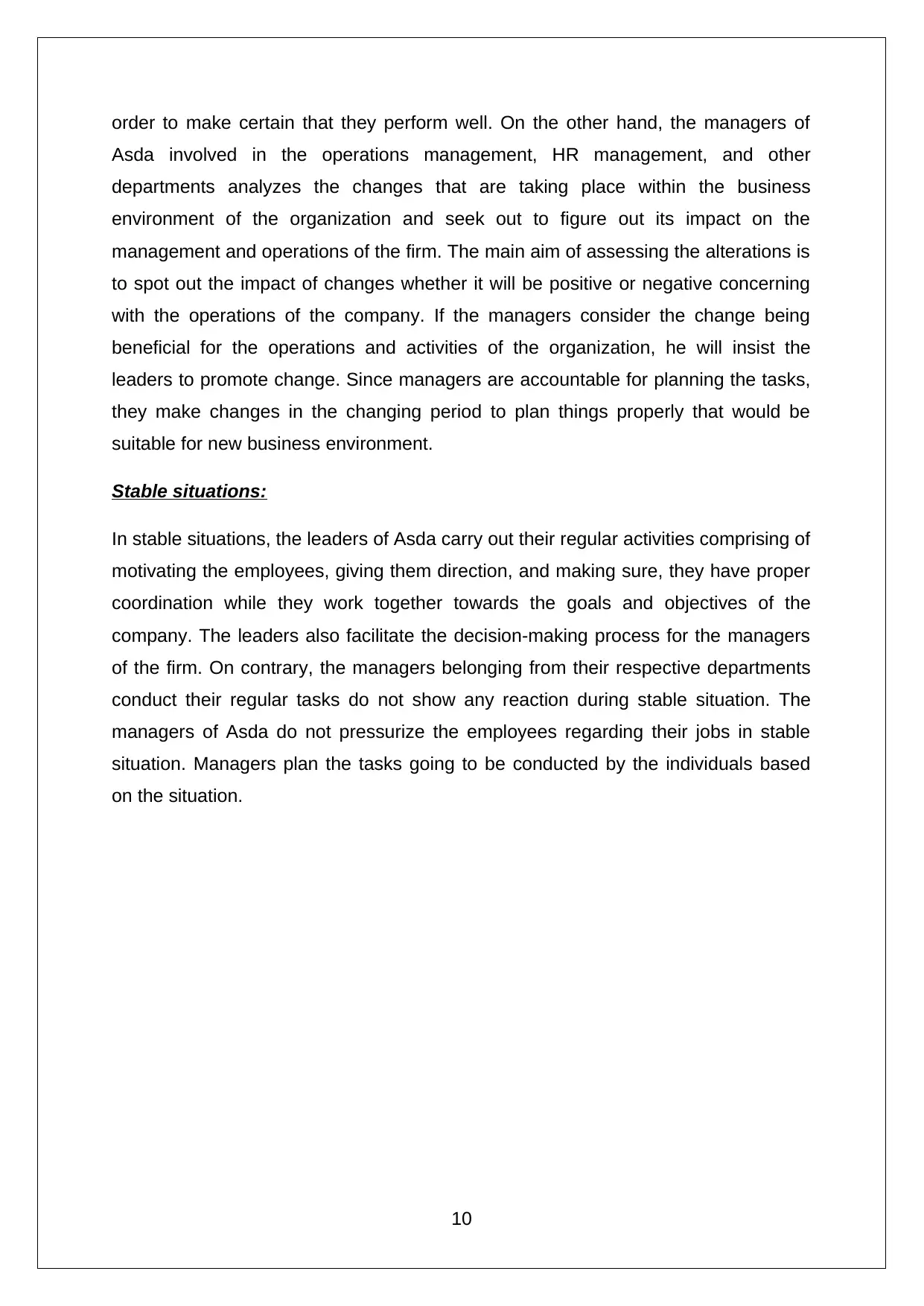
order to make certain that they perform well. On the other hand, the managers of
Asda involved in the operations management, HR management, and other
departments analyzes the changes that are taking place within the business
environment of the organization and seek out to figure out its impact on the
management and operations of the firm. The main aim of assessing the alterations is
to spot out the impact of changes whether it will be positive or negative concerning
with the operations of the company. If the managers consider the change being
beneficial for the operations and activities of the organization, he will insist the
leaders to promote change. Since managers are accountable for planning the tasks,
they make changes in the changing period to plan things properly that would be
suitable for new business environment.
Stable situations:
In stable situations, the leaders of Asda carry out their regular activities comprising of
motivating the employees, giving them direction, and making sure, they have proper
coordination while they work together towards the goals and objectives of the
company. The leaders also facilitate the decision-making process for the managers
of the firm. On contrary, the managers belonging from their respective departments
conduct their regular tasks do not show any reaction during stable situation. The
managers of Asda do not pressurize the employees regarding their jobs in stable
situation. Managers plan the tasks going to be conducted by the individuals based
on the situation.
10
Asda involved in the operations management, HR management, and other
departments analyzes the changes that are taking place within the business
environment of the organization and seek out to figure out its impact on the
management and operations of the firm. The main aim of assessing the alterations is
to spot out the impact of changes whether it will be positive or negative concerning
with the operations of the company. If the managers consider the change being
beneficial for the operations and activities of the organization, he will insist the
leaders to promote change. Since managers are accountable for planning the tasks,
they make changes in the changing period to plan things properly that would be
suitable for new business environment.
Stable situations:
In stable situations, the leaders of Asda carry out their regular activities comprising of
motivating the employees, giving them direction, and making sure, they have proper
coordination while they work together towards the goals and objectives of the
company. The leaders also facilitate the decision-making process for the managers
of the firm. On contrary, the managers belonging from their respective departments
conduct their regular tasks do not show any reaction during stable situation. The
managers of Asda do not pressurize the employees regarding their jobs in stable
situation. Managers plan the tasks going to be conducted by the individuals based
on the situation.
10
Paraphrase This Document
Need a fresh take? Get an instant paraphrase of this document with our AI Paraphraser
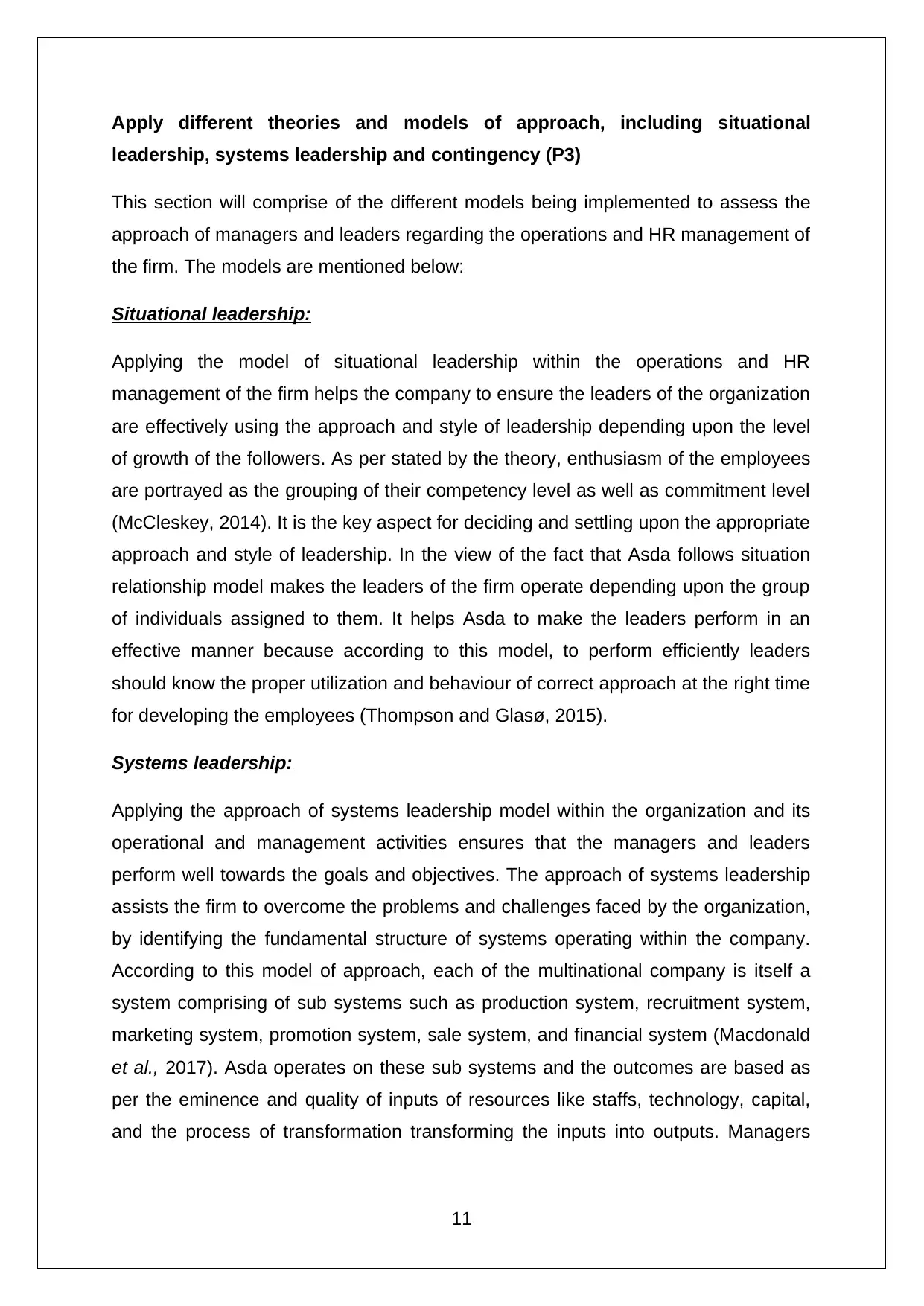
Apply different theories and models of approach, including situational
leadership, systems leadership and contingency (P3)
This section will comprise of the different models being implemented to assess the
approach of managers and leaders regarding the operations and HR management of
the firm. The models are mentioned below:
Situational leadership:
Applying the model of situational leadership within the operations and HR
management of the firm helps the company to ensure the leaders of the organization
are effectively using the approach and style of leadership depending upon the level
of growth of the followers. As per stated by the theory, enthusiasm of the employees
are portrayed as the grouping of their competency level as well as commitment level
(McCleskey, 2014). It is the key aspect for deciding and settling upon the appropriate
approach and style of leadership. In the view of the fact that Asda follows situation
relationship model makes the leaders of the firm operate depending upon the group
of individuals assigned to them. It helps Asda to make the leaders perform in an
effective manner because according to this model, to perform efficiently leaders
should know the proper utilization and behaviour of correct approach at the right time
for developing the employees (Thompson and Glasø, 2015).
Systems leadership:
Applying the approach of systems leadership model within the organization and its
operational and management activities ensures that the managers and leaders
perform well towards the goals and objectives. The approach of systems leadership
assists the firm to overcome the problems and challenges faced by the organization,
by identifying the fundamental structure of systems operating within the company.
According to this model of approach, each of the multinational company is itself a
system comprising of sub systems such as production system, recruitment system,
marketing system, promotion system, sale system, and financial system (Macdonald
et al., 2017). Asda operates on these sub systems and the outcomes are based as
per the eminence and quality of inputs of resources like staffs, technology, capital,
and the process of transformation transforming the inputs into outputs. Managers
11
leadership, systems leadership and contingency (P3)
This section will comprise of the different models being implemented to assess the
approach of managers and leaders regarding the operations and HR management of
the firm. The models are mentioned below:
Situational leadership:
Applying the model of situational leadership within the operations and HR
management of the firm helps the company to ensure the leaders of the organization
are effectively using the approach and style of leadership depending upon the level
of growth of the followers. As per stated by the theory, enthusiasm of the employees
are portrayed as the grouping of their competency level as well as commitment level
(McCleskey, 2014). It is the key aspect for deciding and settling upon the appropriate
approach and style of leadership. In the view of the fact that Asda follows situation
relationship model makes the leaders of the firm operate depending upon the group
of individuals assigned to them. It helps Asda to make the leaders perform in an
effective manner because according to this model, to perform efficiently leaders
should know the proper utilization and behaviour of correct approach at the right time
for developing the employees (Thompson and Glasø, 2015).
Systems leadership:
Applying the approach of systems leadership model within the organization and its
operational and management activities ensures that the managers and leaders
perform well towards the goals and objectives. The approach of systems leadership
assists the firm to overcome the problems and challenges faced by the organization,
by identifying the fundamental structure of systems operating within the company.
According to this model of approach, each of the multinational company is itself a
system comprising of sub systems such as production system, recruitment system,
marketing system, promotion system, sale system, and financial system (Macdonald
et al., 2017). Asda operates on these sub systems and the outcomes are based as
per the eminence and quality of inputs of resources like staffs, technology, capital,
and the process of transformation transforming the inputs into outputs. Managers
11
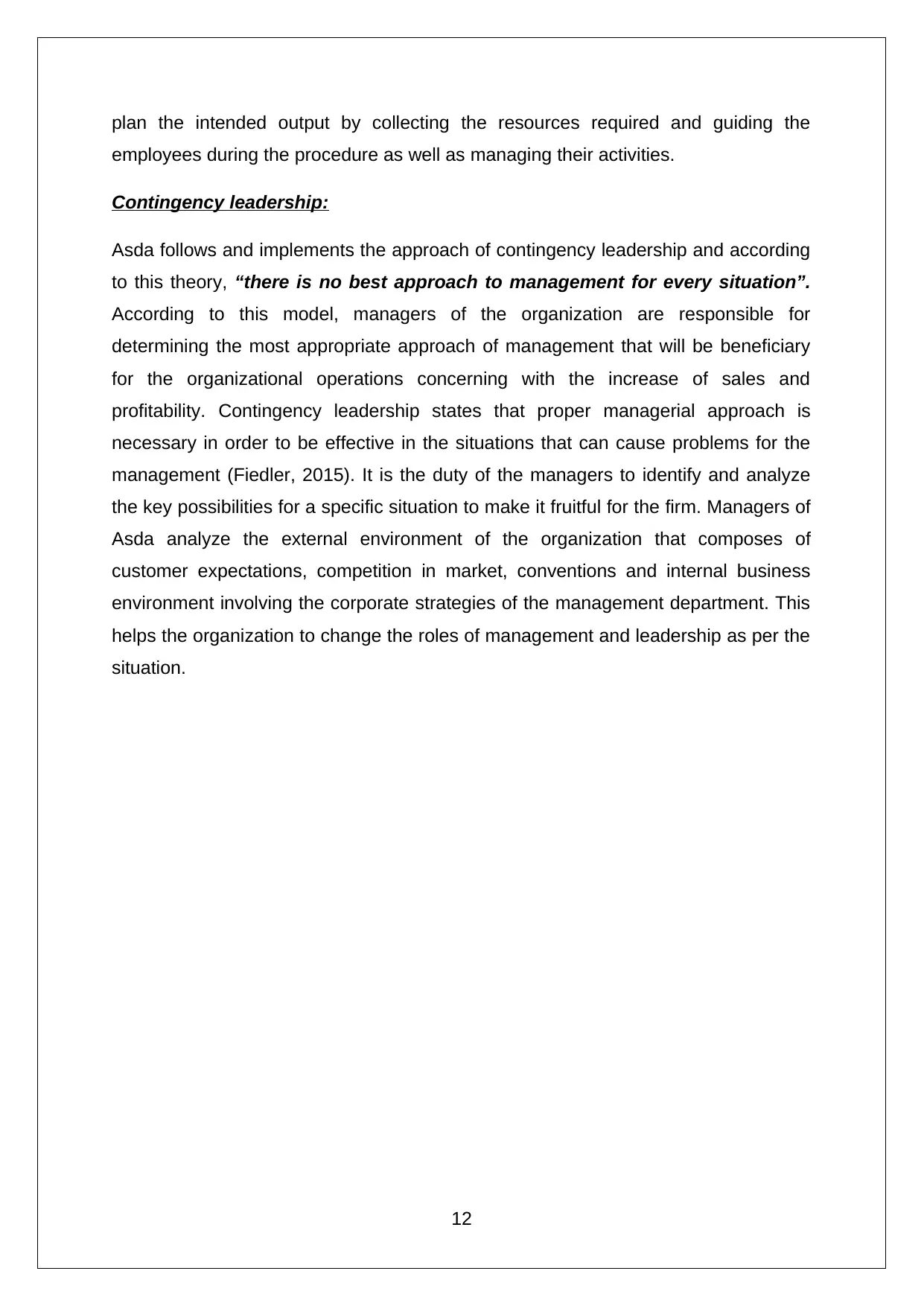
plan the intended output by collecting the resources required and guiding the
employees during the procedure as well as managing their activities.
Contingency leadership:
Asda follows and implements the approach of contingency leadership and according
to this theory, “there is no best approach to management for every situation”.
According to this model, managers of the organization are responsible for
determining the most appropriate approach of management that will be beneficiary
for the organizational operations concerning with the increase of sales and
profitability. Contingency leadership states that proper managerial approach is
necessary in order to be effective in the situations that can cause problems for the
management (Fiedler, 2015). It is the duty of the managers to identify and analyze
the key possibilities for a specific situation to make it fruitful for the firm. Managers of
Asda analyze the external environment of the organization that composes of
customer expectations, competition in market, conventions and internal business
environment involving the corporate strategies of the management department. This
helps the organization to change the roles of management and leadership as per the
situation.
12
employees during the procedure as well as managing their activities.
Contingency leadership:
Asda follows and implements the approach of contingency leadership and according
to this theory, “there is no best approach to management for every situation”.
According to this model, managers of the organization are responsible for
determining the most appropriate approach of management that will be beneficiary
for the organizational operations concerning with the increase of sales and
profitability. Contingency leadership states that proper managerial approach is
necessary in order to be effective in the situations that can cause problems for the
management (Fiedler, 2015). It is the duty of the managers to identify and analyze
the key possibilities for a specific situation to make it fruitful for the firm. Managers of
Asda analyze the external environment of the organization that composes of
customer expectations, competition in market, conventions and internal business
environment involving the corporate strategies of the management department. This
helps the organization to change the roles of management and leadership as per the
situation.
12
⊘ This is a preview!⊘
Do you want full access?
Subscribe today to unlock all pages.

Trusted by 1+ million students worldwide
1 out of 25
Related Documents
Your All-in-One AI-Powered Toolkit for Academic Success.
+13062052269
info@desklib.com
Available 24*7 on WhatsApp / Email
![[object Object]](/_next/static/media/star-bottom.7253800d.svg)
Unlock your academic potential
Copyright © 2020–2025 A2Z Services. All Rights Reserved. Developed and managed by ZUCOL.





